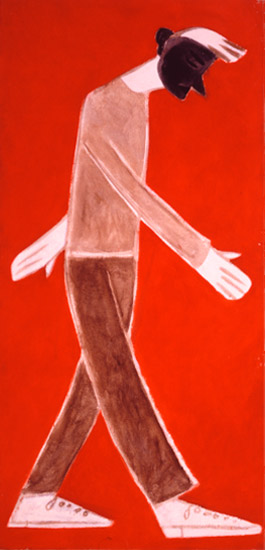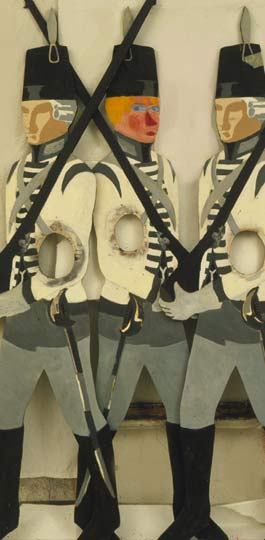Writings in different times and from different positions.
My paintings from 2003 all stem from observations of family life, which has had a powerful and obvious effect on me. The observations are sensually intense experiences of human relations, spaces and situations. Feelings and thoughts aggregated into irrepressible tensions that have erupted and become articulated in paintings.

Nuoren taiteilijan melankolia.
Nuoren taiteilijan melankolia. Taiteilijan omistuksessa. Kuva Juhani Konttinen. 1986.
Eyes, mouth, ears and nose approached and settled in me. In the living room, the sun rose from behind a pillow and the night fell in front of it, all in the space of half an hour. The journey from bed to table was exactly the same distance as between stumbling and falling. When the touching finally happened, everything was in motion, nobody was excluded, all members and thoughts tumbling in one heap.
There was an even or an odd number of windows, you could see both in and out of them all. No curtain could shield the person inside from the world within or without, only the band skirting the walls had trash and shadows in it that were left alone. Trash that entered the light lost their time and vanished, or became essential topics of discussion. There was a floor in the rooms, with all the sounds of life upon it, and much more. There was a mess in the rooms and not much more.
A foot reached towards an ear and a hand towards a nose. Hair hung down and then swung away. All the life that remained between gestures could be seen with the same clarity. A wind of delight ruffled the petals of a poppy that left their colour in the air, girdled with joy. Traces stayed in the memory and passed by. The question was: how much space is enough for being caught?
The table was in front of the window and the shelves next to the window. Everybody had to wake up when the alarm went off. Everything important was in one’s arms, and it was so close. Eyes, mouth, ears and nose merged into an expression that became skin, and the skin became flesh from which issued a voice.

Vastavirtaan. Taiteilijan omistuksessa. Kuva Juhani Konttinen. 1986.
When you stand in front of a surface and see small irregularities in the whiteness that create a pattern of tiny shadows, you want to touch it. When you touch the surface in the centre, you can already feel the claim of the edges. The presence of a painting is in the approach and the pulling back. When you approach a painting physically, its edges escape and approach at the same time. This simultaneity voids the distinction between object and doer. The painting engulfs you when you come close enough. Pulling back from the painting, its edges enclose the image and the figure rises towards you or recedes.
Approaching and pulling back both involve observation and choice. Oil paint is oily and slippery. It has its own distinctive smell and existence. The ritual is simple, paint squeezed on a surface and commitment to it. It is difficult to relate to a painting unless you see you are stumbling over your own limitations. After squeezing out the paint, you must approach it again so that it can be moved onto the next surface.
Red, blue and yellow heaps on the table. Accidental splashes on the walls and the floor, marks, some of them covered in dirt. Reds, blues and yellows emerge from the randomness. They suggest new, shared directions to each other, and I finally touch the mounds of squeezed pigment, moving them onto the next surface.
When a painter approaches the paints and then the canvas, he is visible to others, but not to himself, he is looking ahead. This situation also involves confidence in connection. Hand and brush are two separate things, thought and hand are two separate things, emotion and thought are two separate things. It is not only about painting a painting, but also about bringing together things that are immeasurably far apart. This is a conversation where you must make choices.
Spreading red on a canvas is a decision, and covering it up with green is a decision. Drawing begins and goes on, lines turning into patterns, but also pressing towards an independent decision about figure and movement. Drawing is also in constant dialogue between the edges and the centre. As a marker between enclosed and unbounded space, it struggles in relation to completed movement. When red colour endures other colours and lines upon it, it becomes stronger, lending strength to the new colour by withdrawing deeper into the work. This skin, the result of the concealment of active layers and outcrops of naked surfaces, has a presence and an energy, when each colour is encountered as itself.
The light bends, entering through the window, becoming stronger and weakening. The hands of the clock move round and round. Two skins, touching. A relationship and a meeting you cannot live without.